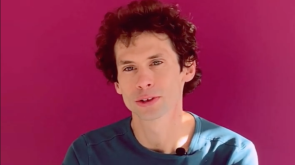
Human Auditory Ecology workshop. Foundations of a new interdisciplinary field
A two-day workshop was organized on two exceptional sites, Biosphere 2 research station in Tucson Arizona, and the Ecole Normale Supérieure-PSL in Paris, to offer a unique opportunity for hearing scientists (psychoacousticians, auditory neuroscientists, modellers, bioacousticians/neuroethologists and audiologists) to meet and discuss with soundscape ecologists, environmental acousticians and geographers. A unique event to lay the foundations for a new field of research.
A unique pluridisciplinary workshop
This pluridisciplinary workshop aimed at reflecting on the possibility of moving behavioral, neuroscientific, computational and clinical hearing sciences towards the study of the human auditory system's ability to perceive the ecological processes at work in natural habitats using the tools, data, concepts and theories offered by modern ecoacoustics. The aim was also to encourage hearing scientist to take note of recent work by environmental geographers and acousticians, and to consider the implications of such studies for experimental and clinical audiology and, more generally, for human health and understanding environmental change in our societies.
The workshop has been organized in partnership with the Ecole normale supérieure - PSL, the IRL iGlobes CNRS, ENS-PSL, University of Arizona, the Museum National d’Histoire Naturelle, and Biosphere 2 University of Arizona. These working sessions were organized in a hybrid format, on line and on site at Biosphere 2 in Oracle, USA, and Ecole normale supérieure in Paris, France.
iGLOBES, a laboratory hosting research at the crossroads of ecology and social science of the environment
""iGLOBES is an international research laboratory, explains Régis Ferrière, head of this unit. iGLOBES stands for Interdisciplinary and Global Environmental Studies. This laboratory was established in 2008 by the French research agency CNRS at the University of Arizona, to work on major environmental problems. At that time, the focus of iGlobes was on water because the University of Arizona is one the the best places in the world to study the issue of water availability and water access. CNRS established this unit to facilitate collaborations to work on this topic. In 2017, I had the opportunity to become the director of this unit. The strategy was to open it up to a broader range of scientific topics. iGlobes is now a unit that studies environmental issues from a social science prospective, and the biodiversity crisis. Since then, we have been a laboratory hosting many research projects at the crossroad of ecology and social science of the environment, and one of this topic has been what the workshop focuses on".
Biosphere 2, a highly symbolic venue for a unique workshop
Biosphere 2 (B2) is one of the world's most unique facilities dedicated to the research and understanding of global scientific issues. The University of Arizona assumed ownership of B2 in July 2011. B2 engages in world-class environmental research, education, and entrepreneurship leading to solutions for humanity’s grand challenges of climate change, biodiversity loss and sustainable development, on Earth and beyond.
When Christian Lorenzi, project initiator, imagined this workshop, and the need to involve as many scientists as possible from all over world in the project, he quickly realized the limitations of working remotely via videoconference. A physical, meaningful meeting place with an infrastructure suited to hosting a working group was essential. Régis Ferrière, involved in this research project from the outset, provided privileged access to this highly symbolic venue.
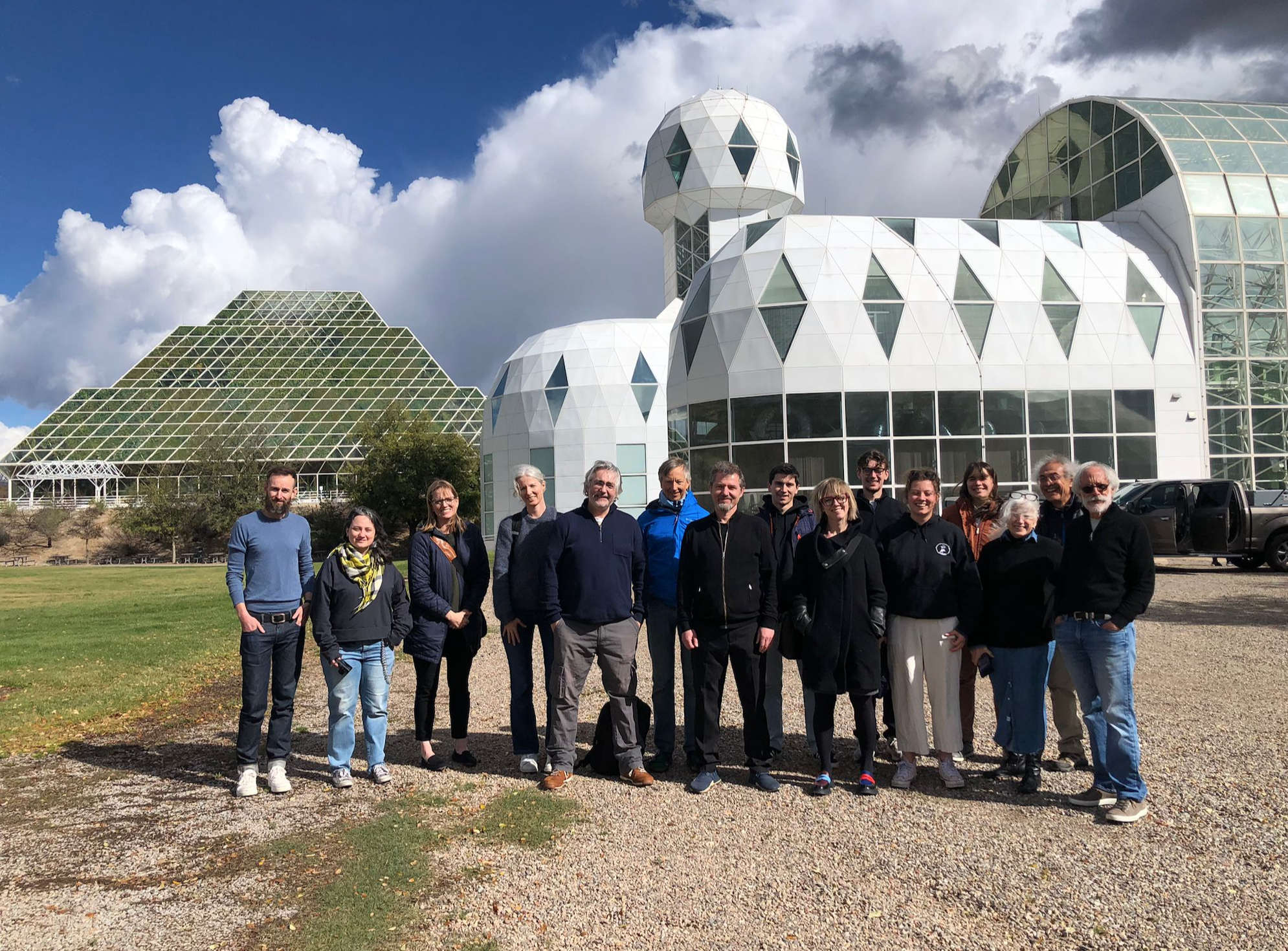
Workshop program
On the first day, the workshop was introduced by Régis Ferrière, Christian Lorenzi and Jérôme Sueur.
Régis Férrière opened the workshop with a presentation of the iGlobes research unit and Biosphere 2.
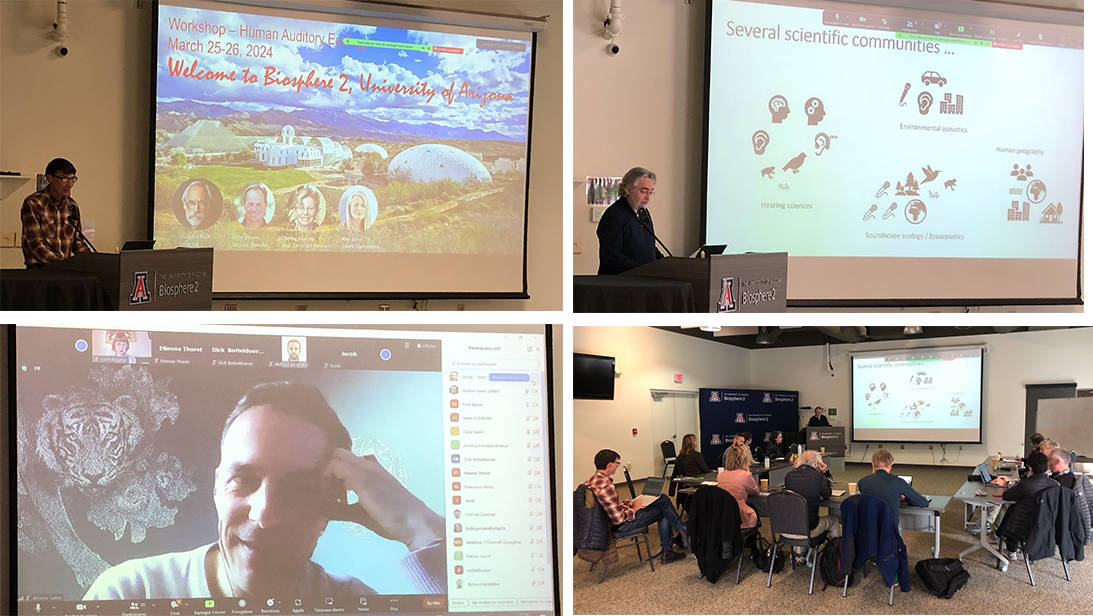
Jérôme Sueur paid tribute to Bernie Krause, a pioneer in soundscape ecology, who accepted to sponsor and be part of this interdisciplinary event.

Human auditory ecology, a new field focusing on the study of human auditory perception of natural soundscapes
Natural soundscapes correspond to the complex arrangements of biological and geophysical sounds shaped by sound propagation through non-anthropogenic habitats. Human auditory ecology is a new field focusing on the study of human auditory perception of natural soundscapes, and more precisely human perception of ecological processes at work in natural habitats. Based on large acoustic databases with high ecological validity collected by ecologists using standardized procedures and material, human auditory ecology investigates the extent to which this presumably ancestral monitoring function of the human auditory system is adapted to specific information conveyed by natural soundscapes, whether it operates throughout the life span or whether it emerges through individual learning or cultural transmission. Beyond fundamental knowledge on human hearing, human auditory ecology should yield a better understanding of how normal-hearing and hearing-impaired listeners monitor rural and city green and blue spaces and benefit from them, and whether rehabilitation devices (hearing aids and cochlear implants) restore natural soundscape perception and emotional responses back to normal. Human auditory ecology should also reveal whether and how humans hear the rapid changes in the environment brought about by human activity.
The workshop was divided into six working sessions:
DAY 1
Session 1 - Statistics of natural soundscapes
This first session was opened by a keynote presentation of soundscape ecology and ecoacoustics by Rachel Buxton (soundscape ecology and ecoacoustics).
This was followed by presentations of material relevant to the topic carried out by three speakers : Fréderic Theunissen (neuro-ethology and signal processing); Josh McDermott (computational hearing sciences); Nicole Miller-Viacava (computational hearing sciences).
Discussions were chaired by Richard McWalter & Etienne Thoret. Amongs the different questions addressed in this session: Could soundscape ecologists help auditory scientists test efficient coding and auditory scene analysis principles? Natural sound databases: What matters : quality, metadata, quantity ?
Session 2 - Monitoring auditory behaviors
This session was opened by a keynote presentation of environmental-sound perception by Valeriy Shafiro (psychoacoustics).
This was followed by presentations carried out by three speakers : Timothy Mullet (soundscape ecology and ecoacoustics); Clara Suied (psychoacoustics); Nicolas Mathevon (bioacoustics). Discussions were chaired by Frédéric Apoux. Amongs the different questions addressed in this session: Are we equiped with an ancestral repertoire of ‘monitoring auditory behaviors’ ? Do we possess auditory mechanisms dedicated to the detection/discrimination of biophony and biodiversity, or detection of specific geophysical sounds (water) ?
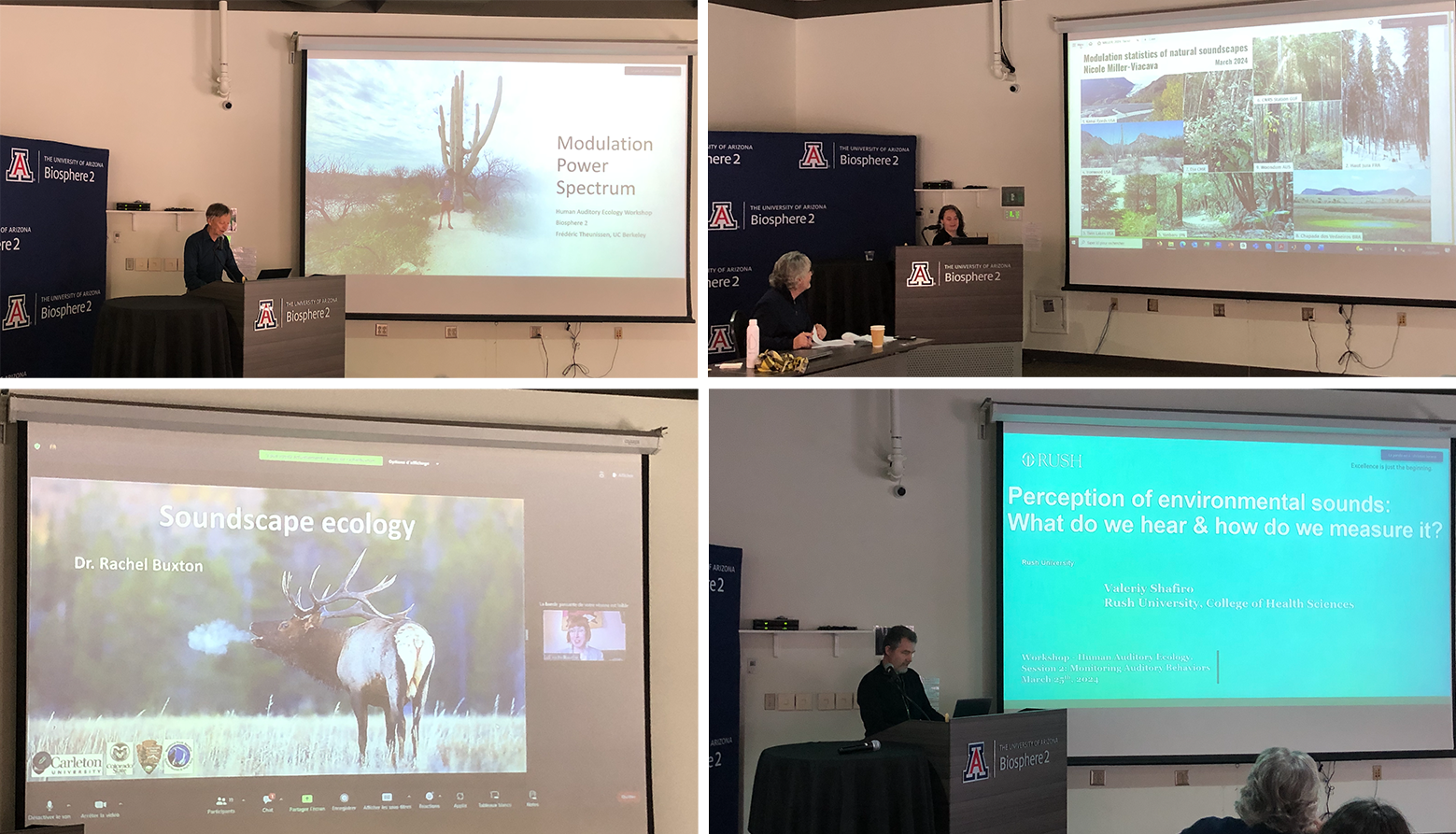
Session 3 - Sensory vs emotional auditory processing
This session was opened by a keynote presentation of emotional processing of environmental sounds by Erin Picou (experimental audiology).
This was followed by presentations carried out by three speakers: Rachel Buxton (soundscape ecology and ecoacoustics); Dick Bottledooren (environmental acoustics, urban planning); Francesco Aletta (environmental acoutics, urban planning).
Discussions were chaired by Christian Lorenzi. Amongs the different questions addressed in this session: Are natural soundcapes ‘special’ for our emotional system ? Could emotions modulate auditory processing of natural scenes ?

DAY 2
Session 4 - Developmental, learning and memory effects
This session was opened by a keynote presentation of developmental studies on environmental sounds by Judit Gervain (auditory development).
This was followed by presentations carried out by two speakers Frédéric Theunissen (auditory neurosciences), Daniel Pressnitzer (psychoacoustics).
Discussions were chaired by Shihab Shamma. Amongs the different questions addressed in this session: Do monitoring auditory functions operate throughout the life span or do they emerge through individual learning or cultural transmission ? Are certain sounds (ie, water, birds) or habitats (ie, savannas) ‘special’ for our auditory brain ?
Session 5 - Effects of hearing loss & hearing aids
This session was opened by a keynote presentation of audiological studies on environmental sounds by Valeriy Shafiro (psychoacoustics and audiology).
This was followed by presentations carried out by two speakers : Dina Lelic (experimental and clinical audiology); Erin Picou (experimental and clinical audiology).
Discussions were chaired by Nicole Miller-Viacava. Amongs the different questions addressed in this session: Do hearing-impaired people loose auditory contact with natural environments ? Does it have any impact on them ? Do hearing aids restore this contact ?
Session 6 - Perception of environmental changes
This final session was opened by a keynote presentation of studies on awareness to environmental changes by Anne Sourdril (human geography).
This was followed by presentations carried out by one speaker: Amandine Gasc (soundscape ecology and ecoacoustics).
Discussions were chaired by Pauline Guinard (human geography). Amongst the questions addressed here: Do we perceive human-induced environmental changes such as those produced by invasive species, pollution, decline in biodiversity or climate change ?

General discussion (all participants): Chair : Christian Lorenzi (psychoacoustics, audiology, modelling).
‘Human auditory ecology’ answers the (urgent) need to build multidisciplinary research programmes attempting to map and explain the ability of normal-hearing and hearing-impaired human listeners to perceive ecological processes underlying habitats marginally affected by human activity through their ears and their brain, with a life-span perspective.
‘Human auditory ecology’ – as discussed during the workshop – could be considered as a sub-field of auditory psychophysics and neurosciences. So, it is meant to encourage hearing scientists who traditionally work on speech and music perception in urban settings to collaborate with soundscape ecologists, ecoacousticians and neuro-ethologists, and share expertise with environmental acousticians and geographers (and maybe other fields such as anthropology, philosophy, etc.). It therefore aims at identifying testable working hypotheses guided by computational models of the human auditory system, to unveil low and high-level auditory mechanisms engaged in the auditory perception of soundscapes associated with natural habitats, how they develop through life and the extent to which they are affected by exposure, learning and culture. Although ‘Human auditory ecology’ aims at improving fundamental knowledge on the human auditory system and how humans interact with natural environments, it also aims at providing novel solutions to screen and rehabilitate hearing loss via hearing aids and cochlear implants.
At the heart of human auditory ecology: our relationship with the natural world.

Bernie Krause concluded the workshop on Day 2. At the age of 85, Bernie Krause expresses the urgent need to raise public awareness of environmental change in the broadest and most effective way possible, through sound art, while encouraging science to progress.
"I am at a place in my life where the things are changing so rapidly and not necessarily in a positive sense with habitat loss and animal loss, that I want to devote the rest of my life to get this information out there based on the field data that I have collected.
I found that working with the Fondation Cartier and finding the ways which they handled the Great animal orchestra, all of the sudden, a lot of people where able to see and understand this work emotionally. And the neat thing about what they found is they have very little narrative, written that people have to absorb, to see and read. What's neat about the soundscapes is that they speak eloquently for themselves. Just basic natural sound.
My goal is to make as much of this archive as possible available to the public in forms of sound art. For me getting the message out there is the most important thing and the Great animal orchestra exhibition is a way to do it. I don't have the energy anymore to make science. I am leaving to you all. It's up to you (scientists) to make it happened. We will make sure that you will get access to all the material. I am happy to help and I am happy to be involved."
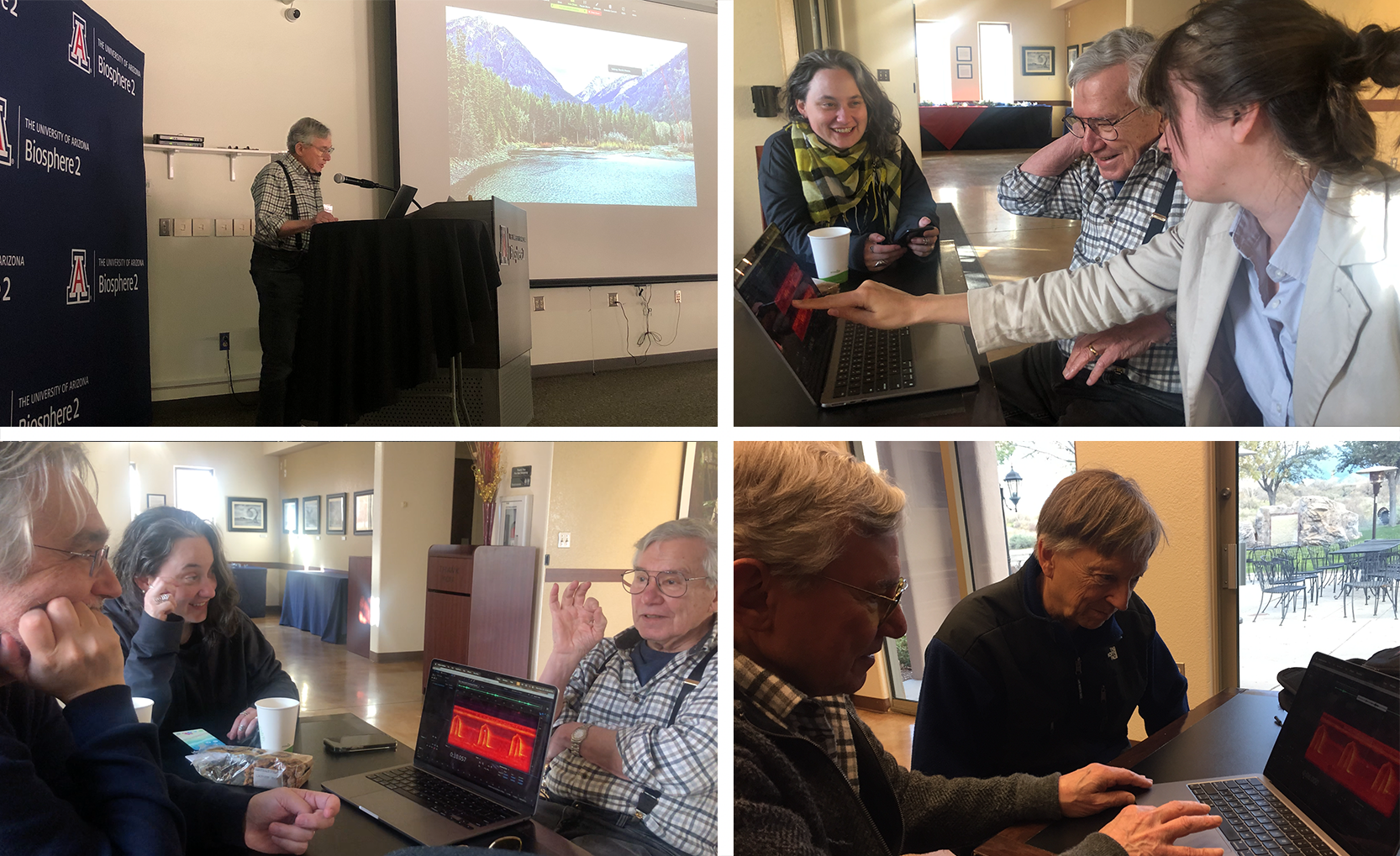
Read more about human auditory ecology
- An innovative research program to shed light on potentially ancestral human auditory mechanisms (article published on the Ens-PSL website - in French)
- Loss of auditory contact with nature (published on the Département d'Etudes Cognitives of ENS website)
- Hearing loss: when the sounds of nature disappear (The Conversation - march 2024. In French)
Some references relevant to human auditory ecology
- Albrecht, Glenn. « Solastalgia: a new concept in health and identity ». PAN (Philosophy, Activism, Nature), no 3, 2005, p. 44‑59, https://doi.org/10.4225/03/584f410704696.
- Albrecht, Glenn. Earth Emotions: New Words for a New World. Cornell University Press, 2019.
- Apoux, F., Miller-Viacava, N., Férriere, R., Dai, H., Krause, B., Sueur, J. & Lorenzi, C. (2023). Auditory discrimination of natural soundscapes. Journal of the Acoustical Society of America, 153, 2706-2723. doi: 10.1121/10.0017972.
- Buxton R.T., Pearson A.L., Allou C., Fristrup K., & Wittemyer G. (2021). A synthesis of health benefits of natural sounds and their distribution in national parks. Proceedings of the National Academy of Sciences of the United States of America, 118. doi: 10.1073/pnas.2013097118.
- De Coensel B., Botteldooren D. (2006) The quiet rural soundscape and how to characterize it. Acta Acustica united with Acustica 92 : 887–897.
- De Coensel B., Botteldooren D. (2010) A model of saliency-based auditory attention to environmental sound. Paper presented at the 20th International Congress on Acoustics (ICA-2010), Sydney, 1–8.
- De Coensel B., Botteldooren D., Muer T. (2003) 1/f Noise in rural and urban soundscapes. Acta Acustica united with Acustica 89 : 287–295.
- Dominoni D.M., Halfwerk W., Baird E., Buxton R.T., Fernandez-Juricic E., Fristrup K.M., McKenna M.F., Mennitt D.J., Perkin E.K., Seymoure B.M., et al. (2020) Why conservation biology can benefit from sensory ecology. Nature Ecology & Evolution 4 : 502–511. doi: 10.1038/s41559-020-1135-4.
- Farina A., Gage S.H. (2017) Ecoacoustics: The ecological role of sounds (John Wiley & Sons, Hoboken). ISBN: 978-1-119-23069-4.
- Gasc A., Anso J., Sueur J. Jourdan H., Desutter-Grandcolas L. (2018) Cricket calling communities as an indicator of the invasive ant Wasmannia auropunctata in an insular biodiversity hotspot. Biological Invasions 20 : 1099–1111. doi : 10.1007/s10530-017-1612-0.
- Gatehouse, S., Elberling, C., & Naylor, G. (1999). Aspects of auditory ecology and psychoacoustic function as determinants of benefits from and candidature for non-linear processing in hearing aids. In A. N. Rasmussen, P. A. Osterhammel, T. Anderson, & T. Poulsen (Eds.), Auditory models and non-linear hearing instruments (18th Danavox Symposium) (pp. 221–233). Copenhagen, Denmark: Holmens Trykkeri.
- Geffen M.N., Gervain J., Werker J.F., Magnasco M.O. (2011) Auditory perception of self-similarity in water sounds. Frontiers in Integrative Neuroscience 5 : doi: 10.3389/fnint.2011.00015.
- Grinfeder, E., Lorenzi, C., Haupert, S., & Sueur, J. (2022). What do we mean by “soundscape”? A functional description. Frontiers in Ecology and Evolution, 10, 894232 doi: 10.3389/fevo.2022.894232.
- Guyot P., Houix O., Misdariis N., Susini P., Pinquier, J., André-Obrecht R. (2017) Identification of categories of liquid sounds. Journal of the Acoustical Society of America 142: 878–889. doi : 10.1121/1.4996124.
- Kang J., Aletta F., Gjestland T.T., Brown L.A., Botteldooren D., Schulte-Fortkamp B., Lercher P., van Kamp I., Genuit K., Fiebig A., Bento Coelho J.L., Maffei L., Lavia L. (2016) Ten questions on the soundscapes of the built environment. Building and Environment 108 : 284–294. doi : 10.1016/j.buildenv.2016.08.011.
- Krause, B. (1987). Bioacoustics, habitat ambience in ecological balance. Whole Earth Review, 57, 14–18. ISBN: 0749-5056.
- Krause, B., Gage, S.H. & Joo., W. (2011). Measuring and interpreting the temporal variability in the soundscape at four places in Sequoia National Park. Landscape Ecology, 26, 1247–1256. https://doi.org/10.1007/ s10980-011-9639-6
- Dina Lelic, Daniel Parker, Petra Herrlin, Florian Wolters & Karolina Smeds (2023). Focusing on positive listening experiences improves hearing aid outcomes in experienced hearing aid users, International Journal of Audiology.doi:10.1080/14992027.2023.2190006
- Lewicki M.S. (2002) Efficient coding of natural sounds. Nature Neuroscience 5: 356-363. doi: 10.1038/nn831.
- Lorenzi, C., Apoux, F., Grinfeder, E., Krause, B., Miller-Viaca, N., & Sueur, J., (2023). Human auditory ecology : Extending hearing research to the perception of natural soundscapes by humans in rapidly-changing environments. Trends in Hearing 27, 1-28. doi: 10.1177/23312165231212032
- McDermott J.H., Simoncelli E.P. (2011) Sound texture perception via statistics of the auditory periphery: evidence from sound synthesis. Neuron 71: 926–940. doi: 10.1016/j.neuron.2011.06.032.
- McWalter R., Dau T. (2017) Cascaded amplitude modulations in sound texture perception. Frontiers in Neuroscience 11: 485. doi: 10.3389/fnins.2017.00485.
- Miller-Viacava, N., Lazard, D., Delmas, T., Krause, B., Apoux, F., & Lorenzi, C. (2023). Sensorineural hearing loss alters auditory discrimination of natural soundscapes. International Journal of Audiology, 1-10. doi: 10.1080/14992027.2023.2272559.
- Mitchell A., Aletta F., Oberman T., Kang J. (2023, Sept) How do we define soundscape ? Paper presented at the Forum Acusticum 2023, 10th Convention of the European Acoustics Association, 11–15 Sept, Turin, Italy.
- Młynarski W., McDermott J.H. (2019) Ecological origins of perceptual grouping principles in the auditory system. Proceedings of the National Academy of Sciences USA 116: 25355–25364. doi: 10.1073/pnas.1903887116.
- Mullet T.C., Farina A., Gage S.H. (2017) The acoustic habitat hypothesis: An ecoacoustics perspective on species habitat selection. Biosemiotics 10: 319–336. doi: 10.1007/s12304-017-9288-5.
- Payne, S.R. (2008). Are perceived soundscapes within urban parks restorative? Proceedings of Acoustics 08, 5519-5524.
- Picou E.M. (2016) How hearing loss and age affect emotional responses to nonspeech sounds. Journal of Speech, Language, and Hearing Research, 59, 1233-1246. doi : 10.1044/2016_JSLHR-H-15-0231
- Pijanowski B.C., Villanueva-Rivera L.J., Dumyahn S.L., Farina A., Krause B.L., Napoletano B.M., Gage S.H., Pieretti N. (2011) Soundscape ecology: the science of sound in the landscape. Bioscience 61: 203–216. doi :10.1525/bio.2011.61.3.6.
- Ratcliffe, E. (2021). Sound and soundscape in restorative natural environments: A Narrative literature review. Frontiers in Psychology, 12, 570563. doi: 10.3389/fpsyg.2021.570563.
- Shafiro V., Luzum N., Moberly A.C., Harris M.S. (2021) Perception of environmental sounds in cochlear implant users: A systematic review. Frontiers in Neuroscience 15: 788899. doi:10.3389/fnins.2021.788899.
- Sourdril A., Welch-Devine M., Andrieu E., Bélaïdi N. (2017) Do April showers bring May flowers? Knowledge and perceptions of local biodiversity influencing understanding of global environmental change. A presentation of the PIAF project. Natures Sciences Sociétés 25 : 56–62. doi : 10.1051/nss/2017009.
- Singh N.C., Theunissen F.E. (2003) Modulation spectra of natural sounds and ethological theories of auditory processing. Journal of the Acoustical Society of America 114 : 3394–3411. doi: 10.1121/1.1624067.
- Suied C., Viaud-Delmon I. (2009) Auditory-visual object recognition time suggests specific processing for animal sounds. PLoS One 4(4): e5256. doi: 10.1371/journal.pone.0005256
- Sueur J., & Farina A. (2015). Ecoacoustics: the ecological investigation and interpretation of environmental sound. Biosemiotics, 8, 493–502. doi : 10.1007/s12304-015-9248-x.
- Thoret, E., Varnet, L., Boubenec, Y., Ferriere, R., Le Tourneau, F.-M., Krause, B. & Lorenzi, C. (2020). Characterizing amplitude and frequency modulation cues in natural soundscapes: A pilot study in four habitats of a biosphere reserve. Journal of the Acoustical Society of America, 147, 3260-3274. doi : 10.1121/10.0001174.
- Traer J., McDermott J.H. (2016) Statistics of natural reverberation enable perceptual separation of sound and space. Proceedings of the National Academy of Sciences USA. 29;113(48): E7856–E7865. doi: 10.1073/pnas.1612524113.



